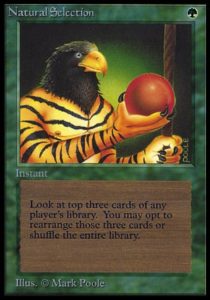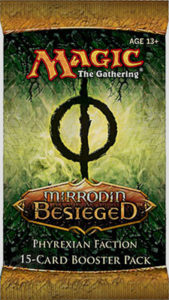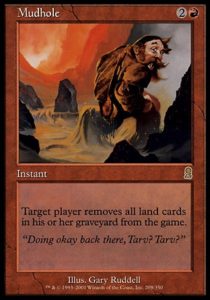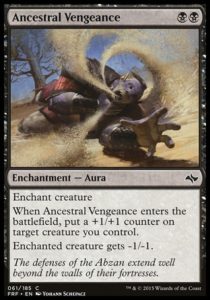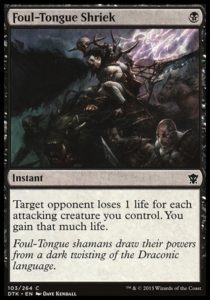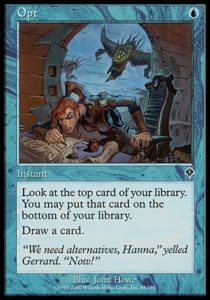I’ve spoken a fair amount about Level Up Moments—those times when we grasp a new concept, internalize a new attitude, or experience an epiphany. Generally, I’ve discussing the many such moments a newer player experiences; these experiences come less frequently to long-time, enfranchized, competitive players. Today, I’d like to talk about a level up moment later in my Magic career: the moment I improved my ability to evaluate cards.
One of the first things we learn as drafters/deckbuilders is to evaluate and categorize cards. Some cards are put into the ‘Bombs’ box, others the ‘Playables’ box, and others are sorted into ‘Removal,’ ‘Filler’ and ‘Unplayable’ (a water-damaged box with a sad face drawn in faded Sharpie). Card evaluation is an essential skill—it’s a good drafter’s B.R.E.A.D. and butter. Once we can recognize cards as belonging to a certain category, we can focus more of our mental energy on building a coherent deck, reading signals, and having a full curve.
I returned to the game in the summer of 2010 (after a decade-long absence), just in time for Scars of Mirrodin. By the time Mirrodin Besieged came out, I was drafting every week and doing reasonably well at Jim Hanley’s Universe. For the first time in my life, I was playing competitive, non-kitchen table (well, technically any-room floor) Magic. This led to me watching my first Pro Tour, PT Paris 2011 (also known as PT Cawblade).
When I tuned into the Limited portion, my eyes went wide. There was a [casthaven]Bladed Sentinel[/casthaven] on the battlefield—a card that I was trained to essentially ignore as bad filler (it died to every ubiquitous [casthaven]Shatter[/casthaven] effect and had a lackluster body for its mana cost). I’m fairly certain I saw someone running [casthaven]Spiraling Duelist[/casthaven], an unplayable card that existed only to trap drafters… right? Why were the best players in the world playing with unplayables?
That day, I learned the first (simple) reason why professional players play bad cards: in a draft where everyone is good at Magic, everyone recognizes and drafts the good cards. The pickings tend to be slimmer when there isn’t someone at the table scooping up every copy of [casthaven]Neurok Spy[/casthaven] and [casthaven]Gruesome Encore[/casthaven] they can find. The best players accordingly have to be make do with worse cards and play a lot more ‘filler.’
The more important lesson came much, much later, and wasn’t really internalized until this year. My teacher was Chris Manning, an old school pro and Team Draft League champion. A couple seasons ago, I subbed a match (I think) for his team. He and his teammate were debating Chris’ desire to play [casthaven]Ancestral Vengeance[/casthaven] (a very bad removal spell, practically unplayable in the context of the tricolor, 2/2-rife Fate-Khans-Khans draft format) over some filler like an [casthaven]Alesha’s Vanguard[/casthaven] or [casthaven]Diplomacy of the Wastes[/casthaven].
None of the aforementioned cards were good, but the color-comitting [casthaven]Ancestral Vengeance[/casthaven] was obviously the worst option for his Mardu aggro deck (if I recall correctly—I don’t think he was on WB Warriors). Manning really wanted to play it, however, and argued that it was better for his deck than the other options (even though one was essentially unplayable and the other were filler, a higher tiered ‘box’). So, he played it, and sure enough, most of the time he drew it, it was more advantageous than the 3/3 or semi-[casthaven]Coercion[/casthaven] would have been. In the context of his deck and its needs, he chose the superior tool, even though it was a ‘worse’ card. Chris Manning opened my eyes to one of the big differences between decent and great Limited players:
Decent Limited players categorize their cards into discreet boxes and ignore unplayables.
Great Limited players evaluate all cards, even their filler and unplayables.
Sure, great players, just like decent players, prefer to fill their decks with nothing but top-shelf cards. However, in Limited we all must make do with Limited resources. A great player will consider the utility of every card, even those as awful as [casthaven]Index[/casthaven], [casthaven]Codex Shredder[/casthaven], [casthaven]Prism Ring[/casthaven], and [casthaven]Dreadwaters[/casthaven]. Sure, they’re awful and generally a 0-for-1, but in the right situation, they might be more useful than a ‘better’ card or an extra land.
Perhaps [casthaven]Prism Ring[/casthaven] will be the last piece you need to enable your [casthaven]Thopter Spy Network[/casthaven] or [casthaven]Dreadwaters[/casthaven] will help break the [casthaven]Sphinx’s Tutelage[/casthaven] control mirror, in lieu of a 2/1 that’ll just die to an [casthaven]Eyeblight Assassin[/casthaven].
I encourage you to look at all of your options, particularly in Sealed and when sideboarding in draft. Cards like [casthaven]Send to Sleep[/casthaven] generally shouldn’t make your main deck unless something has gone horribly wrong, but generally doesn’t mean 100% of the time, and postboard matches can see card values shift dramatically.
To put it another way, there are very, very, very few Magic cards that are wrong to put in your Limited deck 100% of the time. There are plenty of cards that are wrong to put in your deck over 99% of the time. A skilled player will consider and anticipate that small fraction of time when [casthaven]Meditation Puzzle[/casthaven], [casthaven]Spellbook[/casthaven], and [casthaven]Lens of Clarity[/casthaven] are worthy inclusions, as awful as they may be. I’d prefer to avoid ever having to use them, but I’ll do my best to anticipate how and when and why I may have need of them. I encourage you to do the same. And, as always, thanks for reading.
—Zachary Barash
Zachary Barash has been playing Magic on and off since 1994. He loves Limited and drafts every available format (including several that aren’t entirely meant to be drafted). He’s a proud Cube owner, improviser, and game designer. He has an obsession with Indian food that borders on being unhealthy.

